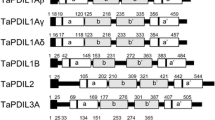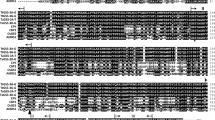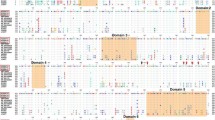Abstract
The TaPR60 gene from bread wheat encodes a small cysteine-rich protein with a hydrophobic signal peptide, predicted to direct the TaPR60 protein to a secretory pathway. It was demonstrated by heterologous expression of recombinant TaPR60 protein that the signal peptide is recognized and cleaved in yeast cells. The full-length gene including promoter sequence of a TaPR60 orthologue was cloned from a BAC library of Triticum durum. A transcriptional promoter-GUS fusion was stably transformed into wheat, barley and rice. The strongest GUS expression in wheat and barley was found in the endosperm transfer cells, while in rice the promoter was active inside the starchy endosperm during the early stages of grain filling. The TaPR60 gene was also used as bait in a yeast two-hybrid screen. Five proteins were identified in the screen, and for some of these prey proteins, the interaction was confirmed by co-immunoprecipitation. The signal peptide binding proteins, TaUbiL1 and TaUbiL2, are homologues of animal proteins, which belong to proteolytic complexes, and therefore may be responsible for TaPR60 processing or degradation of the signal peptide. Other proteins that interact with TaPR60 may have a function in TaPR60 secretion or regulation of this process. Examination of a three dimensional model of TaPR60 suggested that this protein could be involved in binding of lipidic molecules.







Similar content being viewed by others
Abbreviations
- ETC:
-
Endosperm transfer cells
- BETL:
-
Basal endosperm transfer layers
- BAP2:
-
Basal layer type antifungal protein
- DAP:
-
Days after pollination
- dbEST:
-
GenBank expressed sequence tag database
- GUS:
-
β-Glucuronidase
- BAC:
-
Bacterial artificial chromosome
- Y2H:
-
Yeast two-hybrid
- Y3H:
-
yeast three-hybrid
- BD:
-
Binding domain
- AD:
-
Activation domain
- UBL:
-
Ubiquitin like domain
- UBA:
-
Ubiquitin associated domain
- APP:
-
Amyloid precursor protein
- BCP:
-
Blue copper protein
References
Andreeva A, Howorth D, Chandonia JM, Brenner SE, Hubbard TJP, Chothia C, Murzin AG (2008) Data growth and its impact on the SCOP database: new developments. Nucleic Acids Res 36:D419–D425. doi:10.1093/nar/gkm993
Bajaj S, Mohanty A (2005) Recent advances in rice biotechnology-towards genetically superior transgenic rice. Plant Biotechnol J 3:275–307. doi:10.1111/j.1467-7652.2005.00130.x
Barrero C, Muniz LM, Gomez E, Hueros G, Royo J (2006) Molecular dissection of the interaction between the transcriptional activator ZmMRP-1 and the promoter of BETL-1. Plant Mol Biol 62:655–668. doi:10.1007/s11103-006-9047-5
Baud F, Pebaypeyroula E, Cohenaddad C, Odani S, Lehmann MS (1993) Cristal-structure of hydrophobic protein from soybean—a member of a new cysteine-rich family. J Mol Biol 231:877–887. doi:10.1006/jmbi.1993.1334
Becraft PW (2001a) Cell fate specification in the cereal endosperm. Semin Cell Dev Biol 12:387–394. doi:10.1006/scdb.2001.0268
Becraft PW (2001b) Plant steroids recognized at the cell surface. Trends Genet 17:60–62. doi:10.1016/S0168-9525(00)02165-X
Bedford FK, Kittler JT, Muller E, Thomas P, Uren JM, Merlo D, Wisden W, Triller A, Smart TG, Moss SJ (2001) GABA(A) receptor cell surface number and subunit stability are regulated by the ubiquitin-like protein Plic-1. Nat Neurosci 4:908–916. doi:10.1038/nn0901-908
Berman HM, Westbrook J, Feng Z, Gilliland G, Bhat TN, Weissig H, Shindyalov IN, Bourne PE (2000) The protein data bank. Nucleic Acids Res 28:235–242. doi:10.1093/nar/28.1.235
Biggins S, Ivanovska I, Rose MD (1996) Yeast ubiquitin-like genes are involved in duplication of the microtubule organizing center. J Cell Biol 133:1331–1346. doi:10.1083/jcb.133.6.1331
Bolhuis A, Matzen A, Hyyrylainen HL, Kontinen VP, Meima R, Chapuis J, Venema G, Bron S, Freudl R, van Dijl JM (1999) Signal peptide peptidase- and ClpP-like proteins of Bacillus subtilis required for efficient translocation and processing of secretory proteins. J Biol Chem 274:24585–24592. doi:10.1074/jbc.274.35.24585
Brands A, Ho THD (2002) Function of a plant stress-induced gene, HVA22. Synthetic enhancement screen with its yeast homolog reveals its role in vesicular traffic. Plant Physiol 130:1121–1131. doi:10.1104/pp.007716
Broekaert WF, Cammue BPA, DeBolle MFC, Thevissen K, DeSamblanx GW, Osborn RW (1997) Antimicrobial peptides from plants. Crit Rev Plant Sci 16:297–323. doi:10.1080/713608148
Burton RA, Shirley NJ, King BJ, Harvey AJ, Fincher GB (2004) The CesA gene family of barley. Quantitative analysis of transcripts reveals two groups of co-expressed genes. Plant Physiol 134:224–236. doi:10.1104/pp.103.032904
Callebaut I, Labesse G, Durand P, Poupon A, Canard L, Chomilier J, Henrissat B, Mornon JP (1997) Deciphering protein sequence information through hydrophobic cluster analysis (HCA): current status and perspectives. Cell Mol Life Sci 53:621–645. doi:10.1007/s000180050082
Cenci A, Chantret N, Kong X, Gu Y, Anderson OD, Fahima T, Distelfeld A, Dubcovsky J (2003) Construction and characterization of a half million clone BAC library of durum wheat (Triticum turgidum ssp. durum). Theor Appl Genet 107:931–939. doi:10.1007/s00122-003-1331-z
Chen L, Madura K (2002) Rad23 promotes the targeting of proteolytic substrates to the proteasome. Mol Cell Biol 22:4902–4913. doi:10.1128/MCB.22.13.4902-4913.2002
Cruz-Garcia F, Hancock CN, Kim D, McClure B (2005) Stylar glycoproteins bind to S-RNase in vitro. Plant J 42:295–304. doi:10.1111/j.1365-313X.2005.02375.x
Curtis MD, Grossniklaus U (2003) A gateway cloning vector set for high-throughput functional analysis of genes in planta. Plant Physiol 133:462–469. doi:10.1104/pp.103.027979
Diaz I, Martinez M, Isabel-LaMoneda I, Rubio-Somoza I, Carbonero P (2005) The DOF protein, SAD, interacts with GAMYB in plant nuclei and activates transcription of endosperm-specific genes during barley seed development. Plant J 42:652–662. doi:10.1111/j.1365-313X.2005.02402.x
Doan DNP, Linnestad C, Olsen OA (1996) Isolation of molecular markers from the barley endosperm coenocyte and the surrounding nucellus cell layers. Plant Mol Biol 31:877–886. doi:10.1007/BF00019474
Dong J, Kim ST, Lord EM (2005) Plantacyanin plays a role in reproduction in Arabidopsis. Plant Physiol 138:778–789. doi:10.1104/pp.105.063388
Drea S, Leader DJ, Arnold BC, Shaw P, Dolan L, Doonan JH (2005) Systematic spatial analysis of gene expression during wheat caryopsis development. Plant Cell 17:2172–2185. doi:10.1105/tpc.105.034058
Ellerstrom M, Stalberg K, Ezcurra I, Rask L (1996) Functional dissection of a napin gene promoter: identification of promoter elements required for embryo and endosperm-specific transcription. Plant Mol Biol 32:1019–1027. doi:10.1007/BF00041385
Ezcurra I, Ellerstrom M, Wycliffe P, Stalberg K, Rask L (1999) Interaction between composite elements in the napA promoter: both the B-box ABA-responsive complex and the RY/G complex are necessary for seed-specific expression. Plant Mol Biol 40:699–709. doi:10.1023/A:1006206124512
Fedorova M, van de Mortel J, Matsumoto PA, Cho J, Town CD, VandenBosch KA, Gantt JS, Vance CP (2002) Genome-wide identification of nodule-specific transcripts in the model legume Medicago truncatula. Plant Physiol 130:519–537. doi:10.1104/pp.006833
Fujiwara T, Beachy RN (1994) Tissue specific and temporal regulation of beta-conglycinin gene—roles of the RY repeat and other cis-acting elements. Plant Mol Biol 24:261–272. doi:10.1007/BF00020166
Funakoshi A, Fukamizu Y, Miyasaka K (1999a) Mechanism of cholecystokinin-A-receptor antagonist on human pancreatic exocrine secretion—localization of CCK-A receptor in the human duodenum. Digestion 60:75–80. doi:10.1159/000051459
Funakoshi M, Geley S, Hunt T, Nishimoto T, Kobayashi H (1999b) Identification of XDRP1; a Xenopus protein related to yeast Dsk2p binds to the N-terminus of cyclin A and inhibits its degradation. EMBO J 18:5009–5018. doi:10.1093/emboj/18.18.5009
Funakoshi M, Sasaki T, Nishimoto T, Kobayashi H (2002) Budding yeast Dsk2p is a polyubiquitin-binding protein that can interact with the proteasome. Proc Natl Acad Sci USA 99:745–750. doi:10.1073/pnas.012585199
Gao L, Tu H, Shi ST, Lee KJ, Asanaka M, Hwang SB, Lai MMC (2003) Interaction with a ubiquitin-like protein enhances the ubiquitination and degradation of hepatitis C virus RNA-dependent RNA polymerase. J Virol 77:4149–4159. doi:10.1128/JVI.77.7.4149-4159.2003
Ginalski K, Elofsson A, Fischer D, Rychlewski L (2003) 3D-Jury: a simple approach to improve protein structure predictions. Bioinformatics 19:1015–1018. doi:10.1093/bioinformatics/btg124
Gomez E, Royo J, Guo Y, Thompson R, Hueros G (2002) Establishment of cereal endosperm expression domains: identification and properties of a maize transfer cell-specific transcription factor, ZmMRP-1. Plant Cell 14:599–610. doi:10.1105/tpc.010365
Guex N, Peitsch MC (1997) Swiss-model and the Swiss-PdbViewer: an environment for comparative protein modeling. Electrophoresis 18:2714–2723. doi:10.1002/elps.1150181505
Gutierrez-Marcos JF, Costa LM, Biderre-Petit C, Khbaya B, O’Sullivan DM, Wormald M, Perez P, Dickinson HG (2004) Maternally expressed gene1 is a novel maize endosperm transfer cell-specific gene with a maternal parent-of-origin pattern of expression. Plant Cell 16:1288–1301. doi:10.1105/tpc.019778
Higo K, Ugawa Y, Iwamoto M, Korenaga T (1999) Plant cis-acting regulatory DNA elements (PLACE) database: 1999. Nucleic Acids Res 27:297–300. doi:10.1093/nar/27.1.297
Hiltunen M, Lu A, Thomas AV, Romano DM, Kim M, Jones PB, Xie Z, Kounnas MZ, Wagner SL, Berezovska O, Hyman BT, Tesco G, Bertram L, Tanzi RE (2006) Ubiquilin 1 modulates amyloid precursor protein trafficking and a beta secretion. J Biol Chem 281:32240–32253. doi:10.1074/jbc.M603106200
Hueros G, Varotto S, Salamini F, Thompson RD (1995) Molecular characterization of Bet1, a gene expressed in the endosperm transfer cells of maize. Plant Cell 7:747–757
Hueros C, Gomez E, Cheikh N, Edwards J, Weldon M, Salamini F, Thompson RD (1999) Identification of a promoter sequence from the BETL1 gene cluster able to confer transfer-cell-specific expression in transgenic maize. Plant Physiol 121:1143–1152. doi:10.1104/pp.121.4.1143
Hunt LT, George DG, Yeh LSL (1985) Ragweed allergen RA-3—relationship to some type-1 copper-binding proteins. J Mol Evol 21:126–132. doi:10.1007/BF02100086
John B, Sali A (2003) Comparative protein structure modeling by iterative alignment, model building and model assessment. Nucleic Acids Res 31:3982–3992. doi:10.1093/nar/gkg460
Karplus K, Barrett C, Hughey R (1998) Hidden Markov models for detecting remote protein homologies. Bioinformatics 14:846–856. doi:10.1093/bioinformatics/14.10.846
Kelley LA, MacCallum RM, Sternberg MJE (2000) Enhanced genome annotation using structural profiles in the program 3D-PSSM. J Mol Biol 299:499–520. doi:10.1006/jmbi.2000.3741
Kim S, Mollet JC, Dong J, Zhang KL, Park SY, Lord EM (2003) Chemocyanin, a small basic protein from the lily stigma, induces pollen tube chemotropism. Proc Natl Acad Sci USA 100:16125–16130. doi:10.1073/pnas.2533800100
Kleijnen MF, Shih AH, Zhou PB, Kumar S, Soccio RE, Kedersha NL, Gill G, Howley PM (2000) The hPLIC proteins may provide a link between the ubiquitination machinery and the proteasome. Mol Cell 6:409–419. doi:10.1016/S1097-2765(00)00040-X
Kreps JA, Wu YJ, Chang HS, Zhu T, Wang X, Harper JF (2002) Transcriptome changes for Arabidopsis in response to salt, osmotic, and cold stress. Plant Physiol 130:2129–2141. doi:10.1104/pp.008532
Laskowski RA, Macarthur MW, Moss DS, Thornton JM (1993) Procheck—a program to check the stereochemical quality of protein structures. J Appl Cryst 26:283–291. doi:10.1107/S0021889892009944
Li M, Singh R, Bazanova N, Milligan AS, Shirley N, Langridge P, Lopato S (2008) Spatial and temporal expression of endosperm transfer cell-specific promoters in transgenic rice and barley. Plant Biotechnol J 6:465–476. doi:10.1111/j.1467-7652.2008.00333.x
Lopato S, Borisjuk L, Milligan AS, Shirley N, Bazanova N, Parsley K, Langridge P (2006) Systematic identification of factors involved in post-transcriptional processes in wheat grain. Plant Mol Biol 62:637–653. doi:10.1007/s11103-006-9046-6
Mah AL, Perry G, Smith MA, Monteiro MJ (2000) Identification of ubiquilin, a novel presenilin interactor that increases presenilin protein accumulation. J Cell Biol 151:847–862. doi:10.1083/jcb.151.4.847
Maitz M, Santandrea G, Zhang ZY, Lal S, Hannah LC, Salamini F, Thompson RD (2000) rgf1, a mutation reducing grain filling in maize through effects on basal endosperm and pedicel development. Plant J 23:29–42. doi:10.1046/j.1365-313x.2000.00747.x
Massey LK, Mah AL, Monteiro MJ (2005) Ubiquilin regulates presenilin endoproteolysis and modulates gamma-secretase components, Pen-2 and nicastrin. Biochem J 391:513–525. doi:10.1042/BJ20050491
Matthews PR, Wang MB, Waterhouse PM, Thornton S, Fieg SJ, Gubler F, Jacobsen JV (2001) Marker gene elimination from transgenic barley, using co-transformation with adjacent ‘twin T-DNAs’ on a standard Agrobacterium transformation vector. Mol Breed 7:195–202. doi:10.1023/A:1011333321893
Mayer BJ (1999) Endocytosis: EH domains lend a hand. Curr Biol 9:R70–R73. doi:10.1016/S0960-9822(99)80014-1
Muniz LM, Royo J, Gomez E, Barrero C, Bergareche D, Hueros G (2006) The maize transfer cell-specific type-A response regulator ZmTCRR-1 appears to be involved in intercellular signalling. Plant J 48:17–27. doi:10.1111/j.1365-313X.2006.02848.x
Murashige T, Skoog F (1962) A revised medium for rapid growth and bio assays with tobacco tissue cultures. Physiol Plant 15:473–481. doi:10.1111/j.1399-3054.1962.tb08052.x
Nicholls A, Sharp KA, Honig B (1991) Protein folding and association—insides from the interfacial and thermodynamic properties of hydrocarbons. Proteins 11:281–296. doi:10.1002/prot.340110407
Olsen OA (2004a) Dynamics of maize aleurone cell formation: the “surface-”rule. Maydica 49:37–40
Olsen OA (2004b) Nuclear endosperm development in cereals and Arabidopsis thaliana. Plant Cell 16:S214–S227. doi:10.1105/tpc.017111
Pasquato N, Berni R, Folli C, Folloni S, Cianci M, Pantano S, Helliwell JR, Zanotti G (2006) Crystal structure of peach Pru p 3, the prototypic member of the family of plant non-specific lipid transfer protein pan-allergens. J Mol Biol 356:684–694. doi:10.1016/j.jmb.2005.11.063
Peltier JB, Ripoll DR, Friso G, Rudella A, Cai Y, Ytterberg J, Giacomelli L, Pillardy J, van Wijk KJ (2004) Clp protease complexes from photosynthetic and non-photosynthetic plastids and mitochondria of plants, their predicted three-dimensional structures, and functional implications. J Biol Chem 279:4768–4781. doi:10.1074/jbc.M309212200
Provart NJ, Gil P, Chen WQ, Han B, Chang HS, Wang X, Zhu T (2003) Gene expression phenotypes of Arabidopsis associated with sensitivity to low temperatures. Plant Physiol 132:893–906. doi:10.1104/pp.103.021261
Pummi T, Leskela S, Wahlstrom E, Gerth U, Tjalsma H, Hecker M, Sarvas M, Kontinen VP (2002) ClpXP protease regulates the signal peptide cleavage of secretory preproteins in Bacillus subtilis with a mechanism distinct from that of the Ecs ABC transporter. J Bacteriol 184:1010–1018. doi:10.1128/jb.184.4.1010-1018.2002
Ramachandran GN, Ramakrishnan C, Sasisekharan V (1963) Stereochemistry of polypeptide chain configurations. J Mol Biol 7:95–99. doi:10.1016/S0022-2836(63)80023-6
Rodrigues JCM, Tucker MR, Johnson SD, Hrmova M, Koltunow AGM (2008) Sexual and apomictic (asexual) seed formation in Hieracium requires the plant Polycomb-group gene fertilization independent endosperm (FIE). Plant Cell 20:2372–2386. doi:10.1105/tpc.108.059287
Rost B, Yachdav G, Liu JF (2004) The predictprotein server. Nucleic Acids Res 32:W321–W326. doi:10.1093/nar/gkh377
Ryden LG, Hunt LT (1993) Evolution of protein complexity—the blue copper-containing oxidases and related proteins. J Mol Evol 36:41–66. doi:10.1007/BF02407305
Sali A, Blundell TL (1993) Comperative protein modeling by satisfaction of spatial restrains. J Mol Biol 234:779–815. doi:10.1006/jmbi.1993.1626
Sambrook J, Fritsch EF, Maniatis T (1989) Molecular cloning. A laboratory manual, vol 1, 2 and 3, 2nd edn. Cold Spring Harbor Laboratory Press, New York
Sanchez R, Sali A (1998) Large-scale protein structure modeling of the Saccharomyces cerevisiae genome. Proc Natl Acad Sci USA 95:13597–13602. doi:10.1073/pnas.95.23.13597
Sanford JC, Smith FD, Russell JA (1993) Optimizing the biolistic process for different biological applications. Methods Enzymol 217:483–509. doi:10.1016/0076-6879(93)17086-K
Serna A, Maitz M, O’Connell T, Santandrea G, Thevissen K, Tienens K, Hueros G, Faleri C, Cai G, Lottspeich F, Thompson RD (2001) Maize endosperm secretes a novel antifungal protein into adjacent maternal tissue. Plant J 25:687–698. doi:10.1046/j.1365-313x.2001.01004.x
Shen QX, Chen CN, Brands A, Pan SM, Ho THD (2001) The stress- and abscisic acid-induced barley gene HVA22: developmental regulation and homologues in diverse organisms. Plant Mol Biol 45:327–340. doi:10.1023/A:1006460231978
Sippl MJ (1993) Recognition of errors in 3-dimentional structures of proteins. Proteins 17:355–362. doi:10.1002/prot.340170404
Sippl MJ, Wiederstein M (2008) A note on difficult structure alignment problems. Bioinformatics 24:426–427. doi:10.1093/bioinformatics/btm622
Sokolenko A, Pojidaeva E, Zinchenko V, Panichkin V, Glaser VM, Herrmann RG, Shestakov SV (2002) The gene complement for proteolysis in the Cyanobacterium synechocystis sp. PCC 6803 and Arabidopsis thaliana chloroplasts. Curr Genet 41:291–310. doi:10.1007/s00294-002-0309-8
Thompson RD, Hueros G, Becker HA, Maitz M (2001) Development and functions of seed transfer cells. Plant Sci 160:775–783. doi:10.1016/S0168-9452(01)00345-4
Tingay S, McElroy D, Kalla R, Fieg S, Wang MB, Thornton S, Brettell R (1997) Agrobacterium tumefaciens-mediated barley transformation. Plant J 11:1369–1376. doi:10.1046/j.1365-313X.1997.11061369.x
Wada S, Hamada M, Satoh N (2006) A genomewide analysis of genes for the heat shock protein 70 chaperone system in the ascidian Ciona intestinalis. Cell Stress Chaperones 11:23–33. doi:10.1379/CSC-137R.1
Wang HL, Offler CE, Patrick JW, Ugalde TD (1994) The cellular pathway of photosynthate transfer in the developing wheat-grain. 1. Delineation of a potential transfer pathway using fluorescent dyes. Plant Cell Environ 17:257–266. doi:10.1111/j.1365-3040.1994.tb00291.x
Wu AL, Wang J, Zheleznyak A, Brown EJ (1999) Ubiquitin-related proteins regulate interaction of vimentin intermediate filaments with the plasma membrane. Mol Cell 4:619–625. doi:10.1016/S1097-2765(00)80212-9
Wu SL, Mikhailov A, Kallo-Hosein H, Hara K, Yonezawa K, Avruch J (2002) Characterization of ubiquilin 1, an mTOR-interacting protein. Biochim Biophys Acta-Mol Cell Res 1542:41–56
Zhang Y (2008) I-TASSER server for protein 3D structure prediction. BMC Bioinform 9:40–47. doi:10.1186/1471-2105-9-40
Acknowledgments
We thank Professor U. Grossniklaus for providing us with the collection of pMDC vectors, and Dr. U. Langridge and R. Hosking for assistance with growing plants. This work was supported by the Australian Research Council, the Grains Research and Development Corporation and the Government of South Australia.
Author information
Authors and Affiliations
Corresponding author
Additional information
The nucleotide sequences have been deposited in the GenBank database under GenBankAccession Numbers: FJ459807 (TdPR60), FJ459808 (TaUbiL1), FJ459809 (TaUbiL2), FJ459810 (TaBCP), FJ459811 (TaPlp-P), FJ459812 (TaHVA22L).
Electronic supplementary material
Below is the link to the electronic supplementary material.
11103_2009_9510_MOESM1_ESM.pdf
Supplementary Fig. 1 Alignment of protein sequences of TaUbiL1 (Acc. FJ459808) and TaUbiL2 (Acc. FJ459809) to similar proteins from mammals: mouse Ataxin/Ubiquilin4 (Acc. Q99NB8), human Ubiquilin1 (Acc. EAW62658), rat Ubiquilin1 (Acc. NP_446199). Identical amino acids are in black boxes, similar amino acids are in grey boxes. The UBI domain is underlined with a solid line, the conserved region with a dashed line, and the UBA domain with a dotted line. (PDF 1535 kb)
Rights and permissions
About this article
Cite this article
Kovalchuk, N., Smith, J., Pallotta, M. et al. Characterization of the wheat endosperm transfer cell-specific protein TaPR60. Plant Mol Biol 71, 81–98 (2009). https://doi.org/10.1007/s11103-009-9510-1
Received:
Accepted:
Published:
Issue Date:
DOI: https://doi.org/10.1007/s11103-009-9510-1




